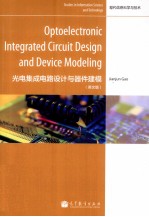图书介绍
光电集成电路设计与器件建模 英文版【2025|PDF|Epub|mobi|kindle电子书版本百度云盘下载】

- Jianjun Gao 著
- 出版社: 北京:高等教育出版社
- ISBN:9787040313260
- 出版时间:2011
- 标注页数:292页
- 文件大小:14MB
- 文件页数:307页
- 主题词:光集成电路-电路设计-英文;光电器件-系统建模-英文
PDF下载
下载说明
光电集成电路设计与器件建模 英文版PDF格式电子书版下载
下载的文件为RAR压缩包。需要使用解压软件进行解压得到PDF格式图书。建议使用BT下载工具Free Download Manager进行下载,简称FDM(免费,没有广告,支持多平台)。本站资源全部打包为BT种子。所以需要使用专业的BT下载软件进行下载。如BitComet qBittorrent uTorrent等BT下载工具。迅雷目前由于本站不是热门资源。不推荐使用!后期资源热门了。安装了迅雷也可以迅雷进行下载!
(文件页数 要大于 标注页数,上中下等多册电子书除外)
注意:本站所有压缩包均有解压码: 点击下载压缩包解压工具
图书目录
1 Introduction1
1.1 Optical Communication System1
1.2 Optoelectronic Integrated Circuit Computer-Aided Design5
1.3 Organization of This Book7
References8
2 Basic Concept of Semiconductor Laser Diodes9
2.1 Introduction9
2.2 Basic Concept10
2.2.1 Atom Energy11
2.2.2 Emission and Absorption12
2.2.3 Population Inversion14
2.3 Structures and Types15
2.3.1 Homojunction and Heterojunction15
2.3.2 Index Guiding and Gain Guiding18
2.3.3 Fabry-Perot Cavity Lasers20
2.3.4 Quantum-Well Lasers22
2.3.5 Distributed Feedback Lasers27
2.3.6 Vertical-Cavity Surface-Emitting Lasers33
2.4 Laser Characteristics34
2.4.1 Single-Mode Rate Equations35
2.4.2 Multimode Rate Equations38
2.4.3 Small-Signal Intensity Modulation40
2.4.4 Small-Signal Frequency Modulation44
2.4.5 Large-Signal Transit Response46
2.4.6 Second Harmonic Distortion48
2.4.7 Relative Intensity Noise51
2.4.8 Measurement Technique55
2.5 Summary58
References58
3 Modeling and Parameter Extraction Techniques of Lasers63
3.1 Introduction63
3.2 Standard Double Heterojunction Semiconductor Lasers64
3.2.1 Large-Signal Model65
3.2.2 Small-Signal Model68
3.2.3 Noise Model72
3.3 Quantum-Well Lasers76
3.3.1 One-Level Equivalent Circuit Model76
3.3.2 Two-Level Equivalent Circuit Model83
3.3.3 Three-Level Equivalent Circuit Model90
3.4 Parameter Extraction Methods95
3.4.1 Direct-Extraction Method95
3.4.2 Semi-Analytical Method105
3.5 Summary111
References111
4 Microwave Modeling Techniques of Photodiodes113
4.1 Introduction113
4.2 Physical Principles114
4.3 Figures of Merit116
4.3.1 Responsivity117
4.3.2 Quantum Efficiency118
4.3.3 Absorption Coefficient119
4.3.4 Dark Current119
4.3.5 Rise Time and Bandwidth121
4.3.6 Noise Currents122
4.4 Microwave Modeling Techniques122
4.4.1 PIN PD124
4.4.2 APD129
4.5 Summary145
References145
5 High-Speed Electronic Semiconductor Devices149
5.1 Overview of Microwave Transistors149
5.2 FET Modeling Technique151
5.2.1 FET Small-Signal Modeling152
5.2.2 FET Large-Signal Modeling155
5.2.3 FET Noise Modeling161
5.3 GaAs/InP HBT Modeling Technique165
5.3.1 GaAs/InP HBT Nonlinear Model166
5.3.2 GaAs/InP HBT Linear Model168
5.3.3 GaAs/InP HBT Noise Model170
5.3.4 Parameter Extraction Methods171
5.4 SiGe HBT Modeling Technique175
5.5 MOSFET Modeling Technique176
5.5.1 MOSFET Small-Signal Model177
5.5.2 MOSFET Noise Model181
5.5.3 Parameter Extraction Methods181
5.6 Summary183
References183
6 Semiconductor Laser and Modulator Driver Circuit Design187
6.1 Basic Concepts187
6.1.1 NRZ and RZ Data188
6.1.2 Optical Modulation190
6.1.3 Optical External Modulator191
6.2 Optoelectronic Integration Technology194
6.2.1 Monolithic Optoelectronic Integrated Circuits195
6.2.2 Hybrid Optoelectronic Integrated Circuits197
6.3 Laser Driver Circuit Design199
6.4 Modulator Driver Circuit Design205
6.4.1 FET-Based Driver Circuit207
6.4.2 Bipolar Transistor-Based Driver Integrated Circuit215
6.4.3 MOSFET-Based Driver Integrated Circuit221
6.5 Distributed Driver Circuit Design222
6.6 Passive Peaking Techniques224
6.6.1 Capacitive Peaking Techniques225
6.6.2 Inductive Peaking Techniques226
6.7 Summary229
References229
7 Optical Receiver Front-End Integrated Circuit Design233
7.1 Basic Concepts of the Optical Receiver234
7.1.1 Signal-to-Noise Ratio234
7.1.2 Bit Error Ratio235
7.1.3 Sensitivity237
7.1.4 Eye Diagram238
7.1.5 Signal Bandwidth240
7.1.6 Dynamic Range241
7.2 Front-End Circuit Design243
7.2.1 Hybrid and Monolithic OEIC244
7.2.2 High-Impedance Front-End245
7.2.3 Transimpedance Front-End247
7.3 Transimpedance Gain and Equivalent Input Noise Current250
7.3.1 S Parameters of a Two-Port Network251
7.3.2 Noise Figure of a Two-Port Network252
7.3.3 Transimpedance Gain253
7.3.4 Equivalent Input Noise Current255
7.3.5 Simulation and Measurement of Transimpedance Gain and Equivalent Input Noise Current257
7.4 Transimpedance Amplifier Circuit Design262
7.4.1 BJT-Based Circuit Design262
7.4.2 HBT-Based Circuit Design263
7.4.3 FET-Based Circuit Design268
7.4.4 MOSFET-Based Circuit Design270
7.4.5 Distributed Circuit Design271
7.5 Passive Peaking Techniques274
7.5.1 Inductive Peaking Techniques274
7.5.2 Capacitive Peaking Techniques277
7.6 Matching Techniques279
7.7 Summary284
References284
Index289
热门推荐
- 1176221.html
- 1651754.html
- 1900456.html
- 931498.html
- 2073709.html
- 3864787.html
- 1193190.html
- 2877982.html
- 360544.html
- 356243.html
- http://www.ickdjs.cc/book_642587.html
- http://www.ickdjs.cc/book_3127857.html
- http://www.ickdjs.cc/book_1254968.html
- http://www.ickdjs.cc/book_333115.html
- http://www.ickdjs.cc/book_2000800.html
- http://www.ickdjs.cc/book_3777440.html
- http://www.ickdjs.cc/book_1550868.html
- http://www.ickdjs.cc/book_1188138.html
- http://www.ickdjs.cc/book_3291050.html
- http://www.ickdjs.cc/book_1778573.html